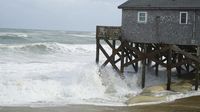Hurricane Erin has unleashed its fury along the US East Coast, with North Carolina’s Outer Banks taking the brunt of the storm’s wrath in late August 2025. The massive Category 2 hurricane, packing sustained winds of up to 110 mph (177 kph) at its peak, has battered coastal communities with fierce winds, towering waves, and relentless rain, even as forecasters predict it will not make direct landfall in the United States. The storm’s outer bands have already left a trail of flooding, evacuations, and daring rescues in their wake.
According to the Associated Press, Erin’s approach began stirring up strong winds and waves on August 20, flooding part of the main highway and surging under beachfront homes on the fragile barrier islands. By Wednesday evening, officials had closed the crucial Highway 12 on Hatteras Island, cutting off the primary route for residents and emergency services. Ocracoke Island’s connection to its ferry terminal was also severed, leaving some communities isolated as water and sand washed over the only roads in and out.
“Dangerous conditions can be felt far from the eye, especially with a system as large as Erin,” warned Will Ray, North Carolina’s emergency management director, as reported by the Associated Press. The National Hurricane Center (NHC) in Miami emphasized that Erin’s tropical storm-force winds stretched across a staggering 500 miles (800 kilometers)—roughly the distance from New York City to Pittsburgh—making it an unusually large and deceptively dangerous storm. “It’s a serious storm,” North Carolina Governor Josh Stein cautioned at a news conference on Wednesday. “No-one should be in the ocean.”
The NHC’s warnings were echoed up and down the East Coast. Life-threatening rip currents and dangerous surf prompted beach closures in New York City, New Jersey, Maryland, and Delaware on August 20 and 21. Nantucket Island in Massachusetts braced for waves exceeding 10 feet (3 meters) and wind gusts up to 35 mph (55 kph) later in the week. Meanwhile, Bermuda was told to expect the full force of the storm by Thursday evening, with storm surges possibly reaching 24 feet (7.3 meters), according to the BBC and AP.
Despite the dire forecasts, some residents and visitors were slow to heed the warnings. At Wrightsville Beach, North Carolina, more than a dozen swimmers had to be rescued from rip currents on August 19, following over 80 rescues the day before. The United States Lifesaving Association notes that over 80% of beach rescues annually are due to rip currents, and the National Weather Service has already recorded at least 27 rip current fatalities in US waters this year alone.
“You can be aware all you want,” Bob Oravec, a National Weather Service forecaster, told the Associated Press. “It can still be dangerous.” Some locals, like Jacob Throne, a Hatteras Island resident, downplayed the threat, recalling past storms: “I remember taking canoes out of my front yard to get to school, so I don’t think it’s gonna be that bad.” Others, such as Vicki Harrison of Hatteras Island, chose to stay put despite evacuation orders, explaining to the BBC, “We would have more trouble evacuating than staying. We’re very safe, we’re all hunkered down, we’ve got plenty of food and plenty of water.”
Still, authorities took no chances. Governor Stein declared a state of emergency on August 19, mobilizing 200 National Guard troops and three swift-water rescue teams to assist with evacuations and rescues. The state’s ferry system evacuated more than 2,200 people from Hatteras and Ocracoke Islands, and officials warned that the largest swells during high tide could cut off villages and homes, exacerbating the vulnerability of these low-lying communities to storm surges and flooding.
Erin’s power has fluctuated dramatically over the past week. The storm reached a formidable Category 5 status with 160 mph (260 kph) winds late last week before weakening to Category 2 as it tracked northward, roughly parallel to the coast. By August 21, Erin was about 200 miles (320 kilometers) southeast of Cape Hatteras, moving north-northeast at 17 mph (28 kph). Forecasters at the NHC anticipated that Erin could regain strength and briefly become a major hurricane again before weakening by Friday, but maintained that landfall was unlikely.
The storm’s impact was not limited to North Carolina. Heavy rainfall drenched Puerto Rico and earlier struck parts of the southeast Bahamas and the Turks and Caicos Islands. In the Outer Banks, rainfall totals were expected to reach about one inch (2.5 centimeters) by Thursday, but with the main threat coming from the sea. Waves as high as 30 feet (9.14 meters) were reported forming along the Atlantic seaboard, and a combination of fierce winds and high surf threatened to erode protective dunes and undermine already vulnerable beachfront homes.
Mandatory evacuations on Hatteras and Ocracoke Islands came at the height of the tourist season, leaving businesses and residents facing difficult choices. “They evacuated all the tourists on Monday morning, and the residents on Tuesday,” Vicki Harrison told the BBC. Lily, a hostess at Miller’s Waterfront Restaurant in Nags Head, noted that while the wind was picking up and the weather had turned cloudy, business had not yet been affected. “Most weather channels are overreacting,” she said, though she admitted it might be a different story farther south.
The National Hurricane Center was also monitoring two additional tropical disturbances far out in the Atlantic, both with the potential to develop into named storms in the coming days. Climate scientists have pointed out that Atlantic hurricanes are now more likely to rapidly intensify into powerful and catastrophic storms, fueled by warmer ocean waters—a trend that raises the stakes for coastal communities every hurricane season.
Erin is the first Atlantic hurricane of the year, but it follows four tropical storms, including Tropical Storm Chantal, which made landfall in early July and caused deadly flooding in North Carolina. The summer of 2025 has already been marked by lethal floods elsewhere, with at least 132 people killed in the Texas Hill Country on July 4 and flash floods claiming two lives in New York City and New Jersey just over a week later, as reported by the Associated Press.
As Hurricane Erin churns northward, its legacy will be measured not only in the damage it leaves behind but also in the resilience of the communities that weather its onslaught. For the Outer Banks and much of the East Coast, the days ahead will be a test of preparation, patience, and perseverance as they ride out yet another storm from the ever-restless Atlantic.


